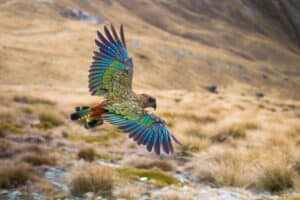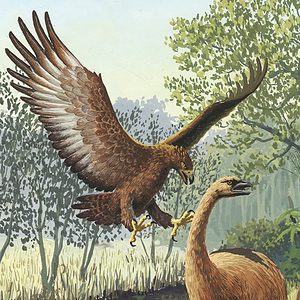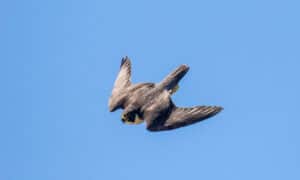Virginia lies in the Mid-Atlantic and southeastern regions of the United States, amid an idyllic landscape of beaches and forests perfect for birding. Many unique birds live year-round, breed, and winter in the state, providing abundant opportunities for spotting feathered friends of all colors. But here, we narrow our interests to birds in varying shades of blue! Discover 11 blue birds in Virginia, along with where they live, what they eat, how they behave, and how to identify them.
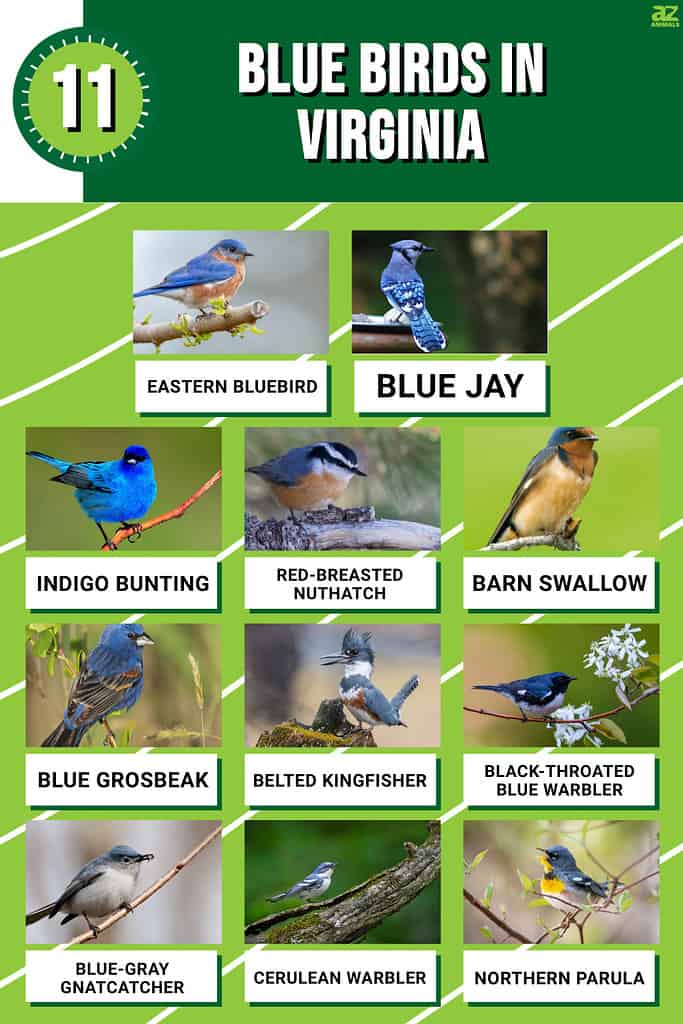
Eastern Bluebird
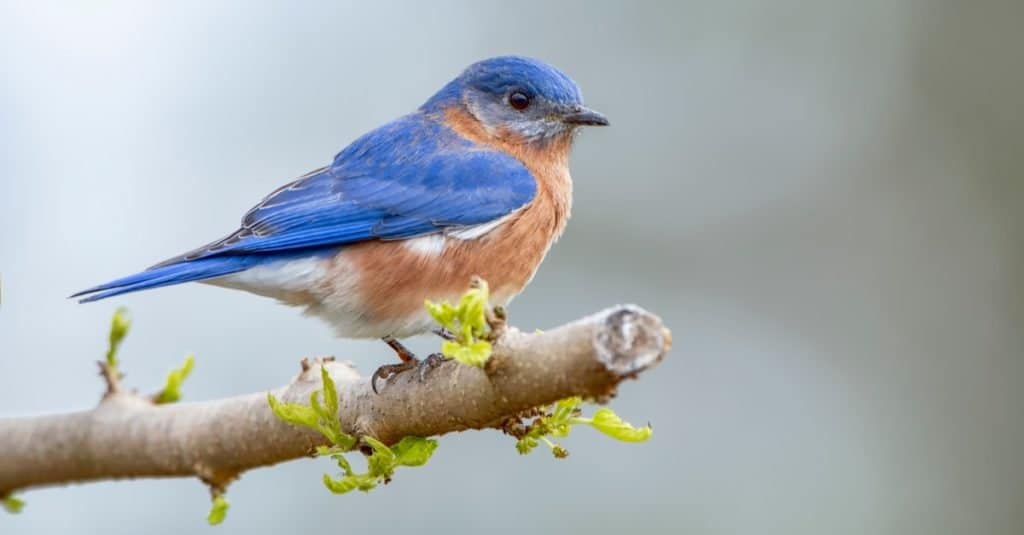
Eastern bluebirds live in Virginia year-round where they inhabit farms and roadsides.
©Bonnie Taylor Barry/Shutterstock.com
Where it lives: The eastern bluebird is a widespread bird of the east. They live year-round throughout Virginia, and you can find them near farms and roads in semi-open country areas.
How it looks: This small, plump thrush has a rounded head with large eyes. They have long wings, but their tails and legs are short. This bluebird is purply blue on the head, back, and wings. And they have rusty red coloring on their breasts and white on their undersides.
What it eats: These little, red-breasted birds eat caterpillars, beetles, crickets, grasshoppers, and spiders.
How it behaves: The eastern bluebird perches on wires and fence posts and forages by catching insects mid-air or fluttering to the ground.
Blue Jay
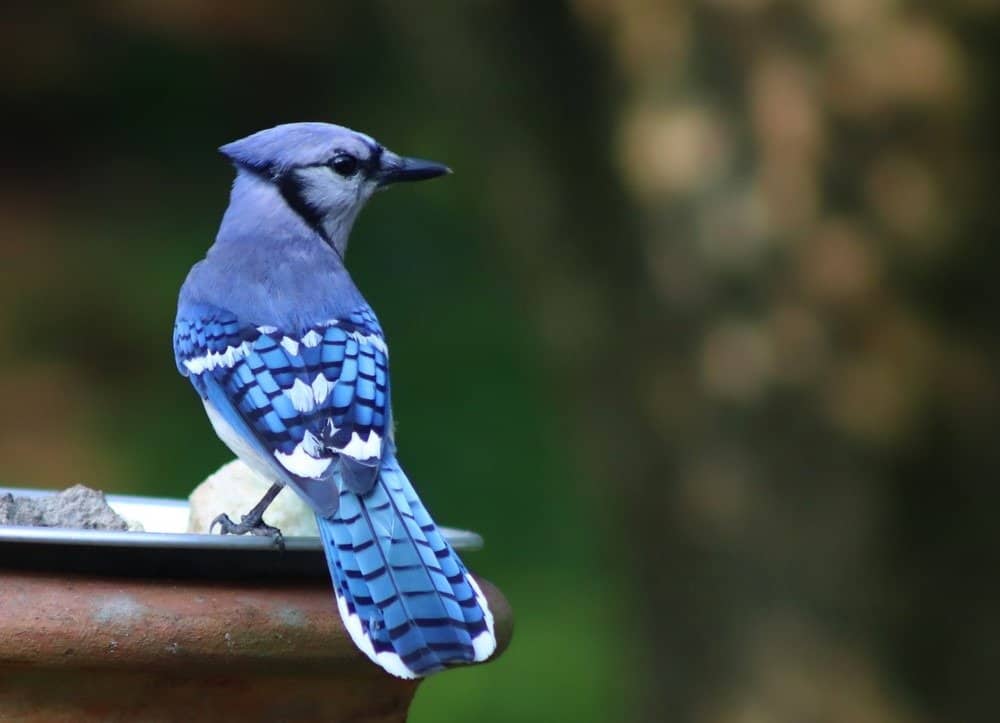
Blue jays live in the eastern United States and are common in suburbs and city parks.
©Eleanor McDonie/Shutterstock.com
Where it lives: Blue jays live all year in the eastern half of the United States, including Virginia. They are common in suburbs and city parks with surrounding woods, preferring to inhabit oak and pine woods.
How it looks: They are relatively large for songbirds and feature crests and long, rounded tails. Their plumage is various shades of blue, black, and white above and white below.
What it eats: Insects, nuts, seeds, fruits, eggs, and carrion
How it behaves: These birds are known for their loud vocalizations and intelligence. You can find them foraging on the ground or in trees and shrubs.
Indigo Bunting
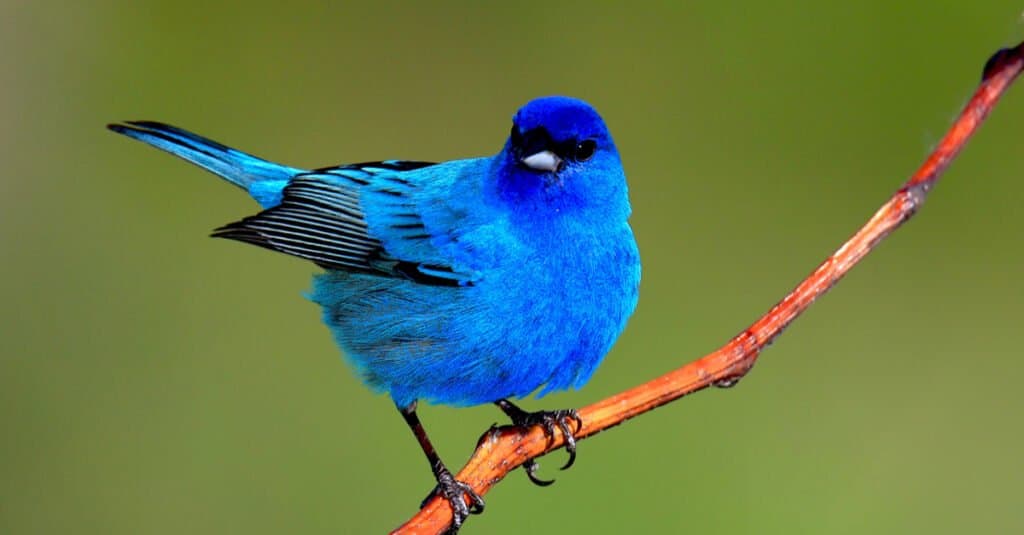
This brilliantly colored bird is bright blue all over with darker coloring on its head.
©John L. Absher/Shutterstock.com
Where it lives: Indigo buntings breed in the east and migrate through the southwest. They spend their springs and summers throughout Virginia, where they inhabit wood edges, roadsides, and fields.
How it looks: This brilliantly colored bird is bright blue all over with darker coloring on its head. It also has a silver beak and black streaking on its wings and tail. They are relatively small and stocky with short tails and thick, conical bills.
What it eats: They eat caterpillars, grasshoppers, aphids, cicadas, berries, twigs, buds, and leaves.
How it behaves: It is one of the most abundant songbirds in the east and spends its days foraging in low vegetation and singing on perches.
Red-breasted Nuthatch
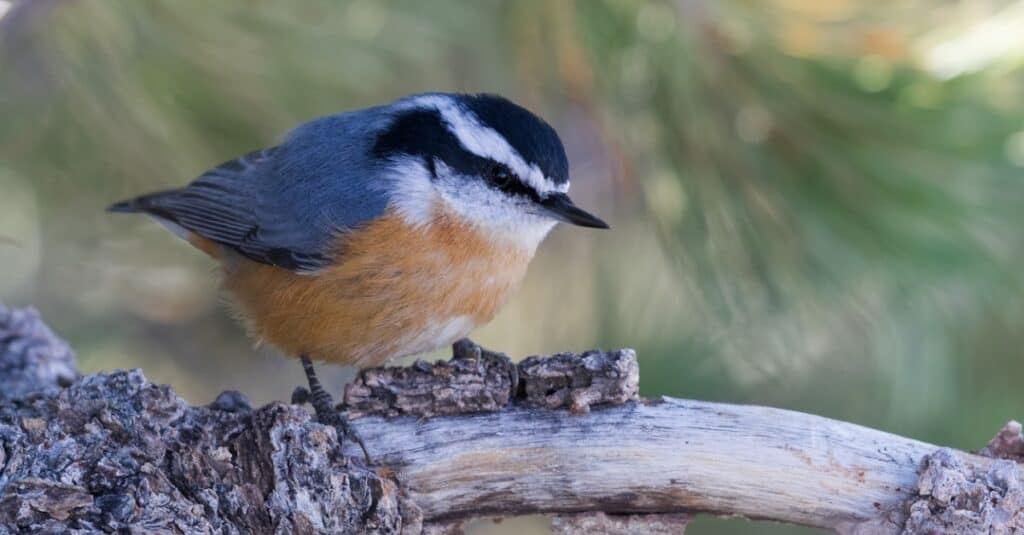
These birds have back and white patterned heads, bluish-gray bodies, and rusty brown underparts.
©iStock.com/M. Leonard Photography
Where it lives: Most red-breasted nuthatch populations in Virginia live in the state only during the winter, except for some in the western part of the state that stay year-round. They prefer coniferous forests, but you can find them in many wooded habitats during winter.
How it looks: They are small and plump and feature broad, short wings and long bills. These birds have back and white patterned heads, bluish-gray bodies, and rusty brown underparts.
What it eats: Caterpillars, ants, spiders, earwigs, beetles, and seeds are common foods for these birds.
How it behaves: They zig-zag as they move swiftly from branch to branch. This species is unafraid of humans and will often get very close to people.
Barn Swallow
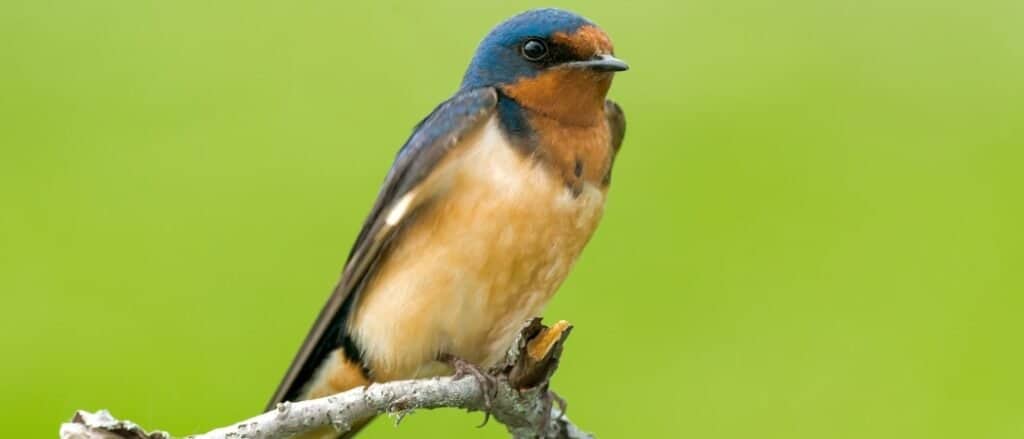
Barn swallows are deep blue above and rufous below, with cinnamon-colored faces and throats.
©Paul Reeves Photography/Shutterstock.com
Where it lives: The barn swallow is one of the most familiar birds across Virginia during the breeding season. You will find them in farms, fields, towns, marshes, and lakes.
How it looks: It is about the same size as a swallow, but features a flat head, broad shoulders, and pointed wings. They are deep blue above and rufous below, with cinnamon-colored faces and throats.
What it eats: These common birds eat flies, beetles, wasps, bees, butterflies, moths, and small pebbles (for grit).
How it behaves: They capture their prey by air, flying low over fields and the water’s surface. You will commonly find them perched on manmade structures.
Blue Grosbeak
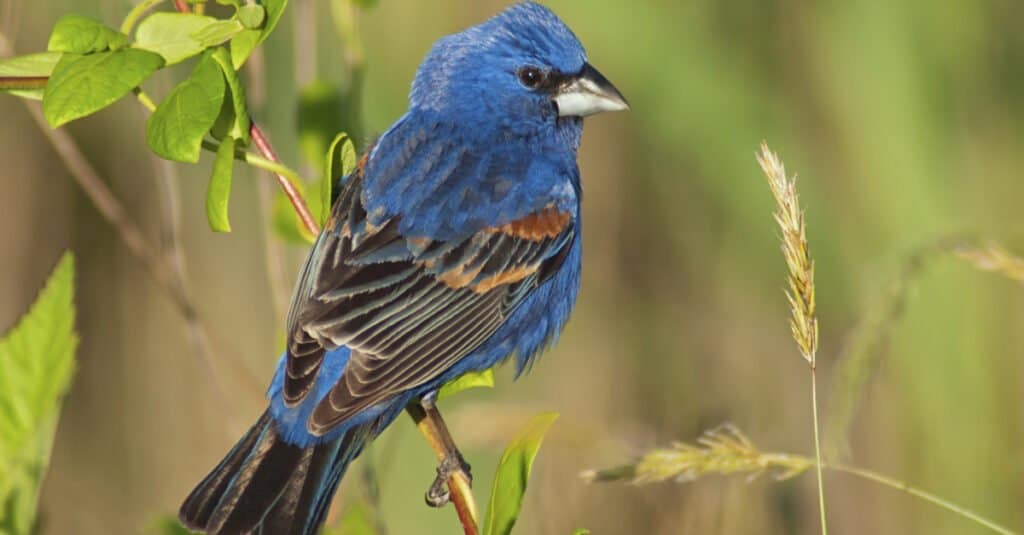
The blue grosbeak is another breeding bird in Virginia, especially common near the coast.
©Michael G. Mill/Shutterstock.com
Where it lives: The blue grosbeak breeds throughout Virginia but is more common along the east coast. They live in brushy fields, woodland edges, roadsides, and streamsides.
How it looks: They are relatively large, stocky songbirds with big bills. Males are deep blue all over with chestnut streaks and silver beaks.
What it eats: Grasshoppers, crickets, snails, beetles, cicadas, and grains are favorites of the blue grosbeak.
How it behaves: They forage on the ground or in low vegetation, and they like to hide in thickets.
Belted Kingfisher
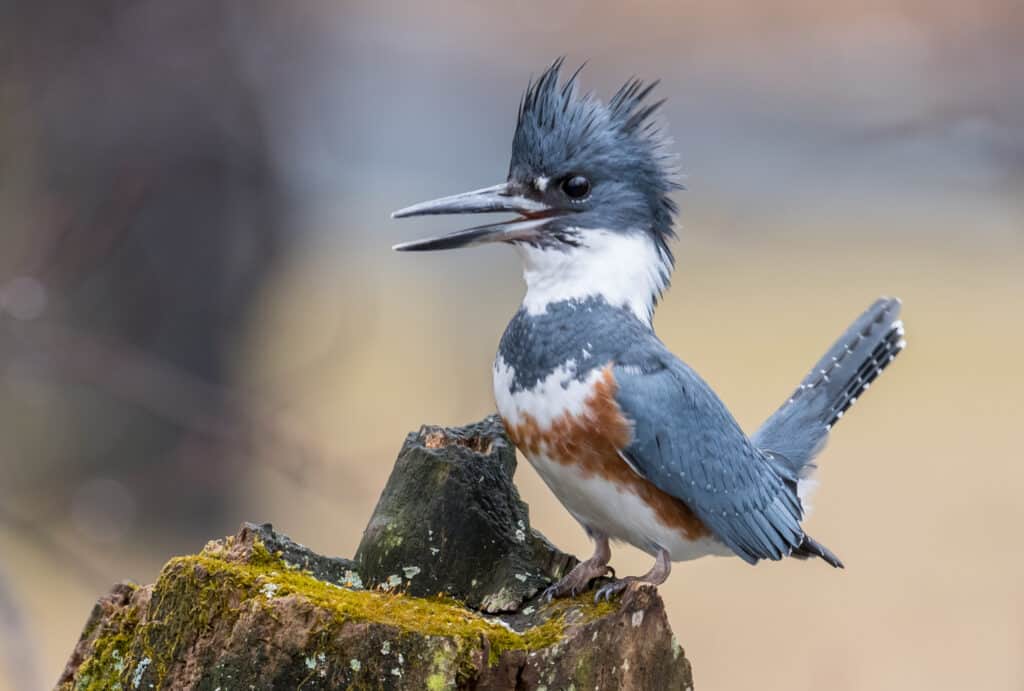
The belted
kingfisher
inhabits many water habitats, like coasts, lakes, and streams.
©Harry Collins Photography/Shutterstock.com
Where it lives: The belted kingfisher lives year-round in Virginia and throughout most of the United States. You will find these birds in most aquatic habitats, such as streams, bays, coasts, and lakes.
How it looks: Another stocky bird, the kingfisher has a large head and a short body. This species is the hipster of birds, with its incredibly stylish crest! They have bluish-gray heads, backs, and wings. Their undersides are white, and they also have white collars.
What it eats: This water-centric bird consumes fish, crustaceans, and mollusks, along with amphibians, reptiles, small mammals, young birds, and berries.
How it behaves: They forage by diving headfirst into the water. You can often hear them before you see them. Listen for their rattling calls.
Black-Throated Blue Warbler
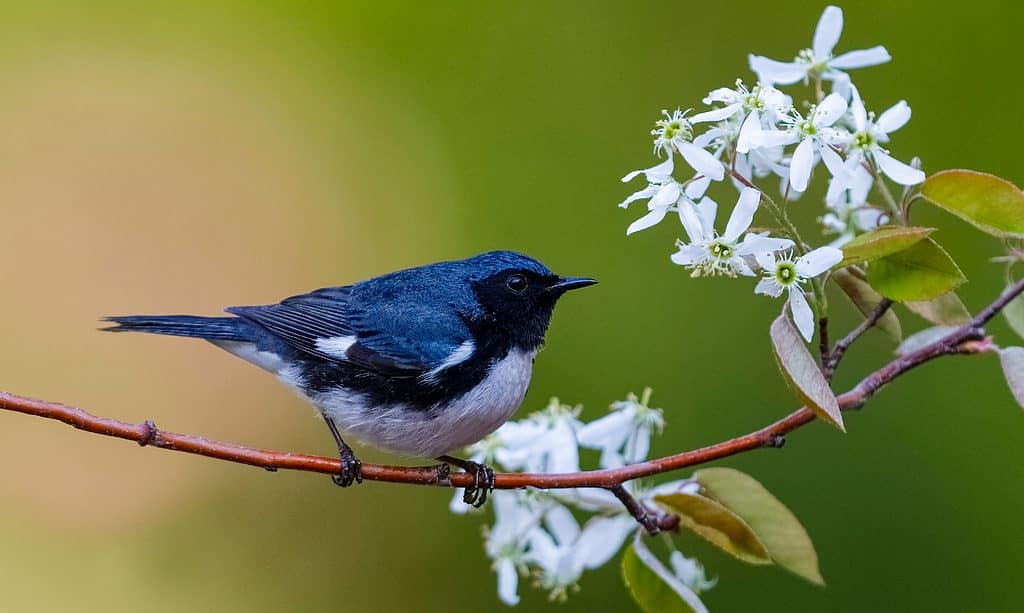
These birds are deep dark iridescent blue above and snow white below, with black throats and faces.
©iStock.com/BrianLasenby
Where it lives: The black-throated blue warbler breeds along the far western side of Virginia and migrates through the rest of the state. They live in the interior of forests and woodlands. And during breeding, they like undisturbed forests with dense undergrowth.
How it looks: They are small birds but relatively large for warblers. These birds are deep dark iridescent blue above and snow white below, with black throats and faces.
What it eats: They commonly eat spiders, flies, caterpillars, and fruits.
How it behaves: They are methodical foragers, thoroughly checking the undersides of leaves and twigs in the lower forest canopy.
Blue-Gray Gnatcatcher
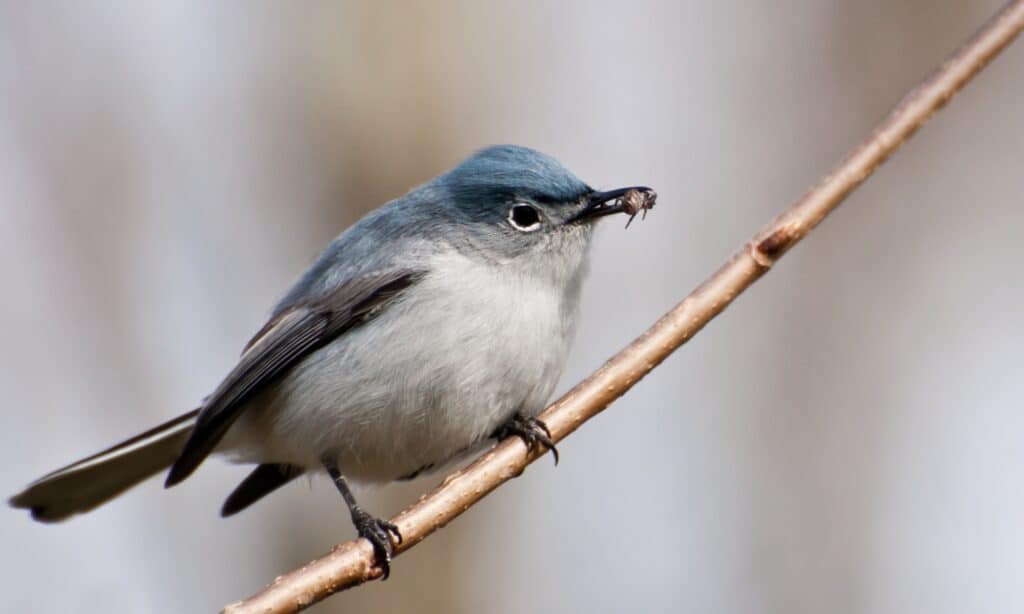
The blue-gray gnatcatcher is a busy forager, flitting about trees and shrubs.
©iStock.com/JasonOndreicka
Where it lives: The blue-gray gnatcatcher breeds throughout Virginia and most of the eastern and southern portions of the U.S. They live in many wooded habitats near rivers, streams, or lakes.
How it looks: This species is tiny and slim with a long tail. They are light bluish gray above and dusty white below with dark tails.
What it eats: This little bird lives on small insects and spiders.
How it behaves: They are active foragers, busily flitting about trees and shrubs. They also speedily dart out from trees to catch insects, before returning to their branch.
Cerulean Warbler
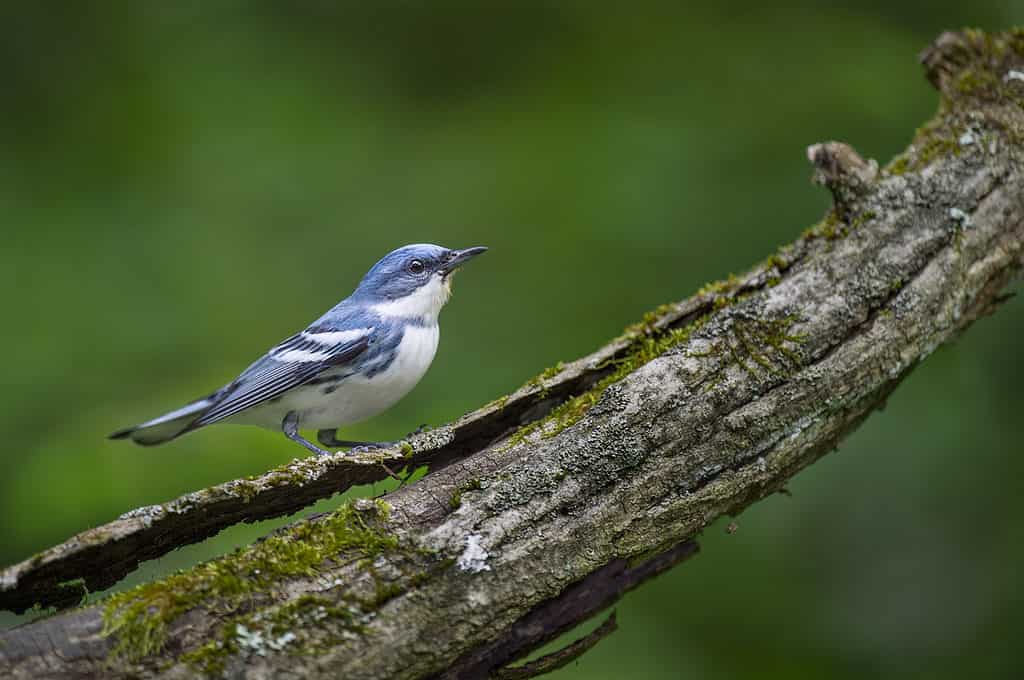
The cerulean warbler migrates through eastern Virginia, stopping in deciduous forests.
©iStock.com/ps50ace
Where it lives: The cerulean warbler migrates through the eastern half of Virginia and occasionally breeds in the western half. They prefer old deciduous forests with tall trees.
How it looks: Small and compact, the cerulean warbler is sky blue above and white below, with dark streaking on the wings and tail. They also have black bills.
What it eats: Cerulean warblers ingest flies, caterpillars, weevils, beetles, and some plant material.
How it behaves: You will find them rapidly moving on the tops of trees or flying out to catch insects mid-air.
Northern Parula
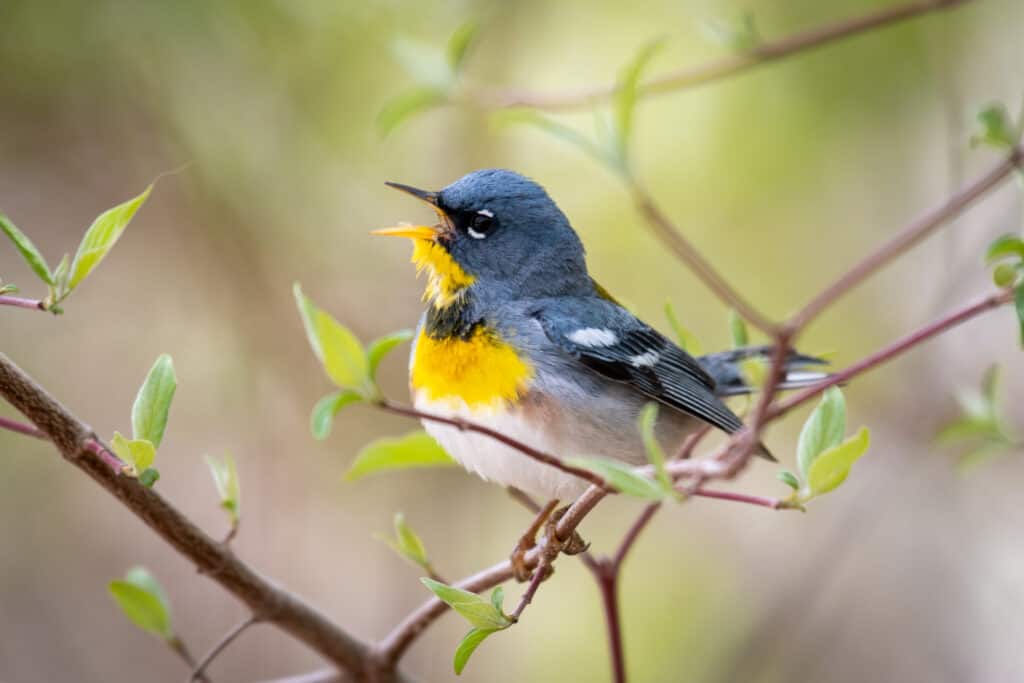
The northern parula is a small warbler that lives in forest canopies during summer and tropical plantations in the winter.
©Nattapong Assalee/Shutterstock.com
Where it lives: Northern parula breed in the eastern half of the United States, including Virginia. Look for them in humid woodlands with hanging Spanish moss.
How it looks: Northern parulas are small wood warblers with short tails and pointy bills. Males are bluish gray above and white below, with mustard yellow patches and black streaking.
What it eats: Spiders, caterpillars, beetles, and flying insects are all prey. They also like seeds and berries.
How it behaves: They quietly move about dense foliage in the treetops, where they hang upside down on twigs.
Summary of 11 Blue Birds in Virginia
| Number | Type of Blue Bird |
|---|---|
| 1 | Eastern Bluebird |
| 2 | Blue Jay |
| 3 | Indigo Bunting |
| 4 | Red-breasted Nuthatch |
| 5 | Barn Swallow |
| 6 | Blue Grosbeak |
| 7 | Belted Kingfisher |
| 8 | Black-Throated Blue Warbler |
| 9 | Blue-Gray Gnatcatcher |
| 10 | Cerulean Warbler |
| 11 | Northern Parula |
The photo featured at the top of this post is © Jim Beers/Shutterstock.com
Sources
- IUCN RedList, Available here: https://www.iucnredlist.org/
Thank you for reading! Have some feedback for us? Contact the AZ Animals editorial team.



